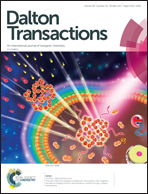NMR analysis of an Fe(i)–carbene complex with strong magnetic anisotropy†
Abstract
A tricoordinated FeI complex with two cyclic-alkyl(amino) carbene (cAAC) and one chlorido ligand, (cAAC)2FeCl (1), is studied by means of 1H NMR spectroscopy and DFT calculations. Due to the cAAC ligands, which can take significant amounts of spin density from the metal center, and due to the magnetic anisotropy of the FeI ion (P. P. Samuel et al., J. Am. Chem. Soc., 2014, 136, 11964–11971), compound 1 is a rare example of a paramagnetic d-block compound which is expected to have significant contributions from both contact and pseudocontact terms to the hyperfine NMR shift. Compound 1 is fluxional, which makes the analysis of its 1H NMR spectrum more difficult but allows a preliminary assignment from EXSY spectra. Then, a software-aided approach enabled a satisfactory signal assignment of all protons which are distanced from the FeI center and carbene cyclic core, and thereby the extraction of the axial and rhombic components of the magnetic susceptibility anisotropy tensor (Δχ). Components of Δχ enable the calculation of zero-field spitting D and E parameters from solution NMR measurements of 1, and these parameters are compared to previously reported experimental and theoretical values.



 Please wait while we load your content...
Please wait while we load your content...